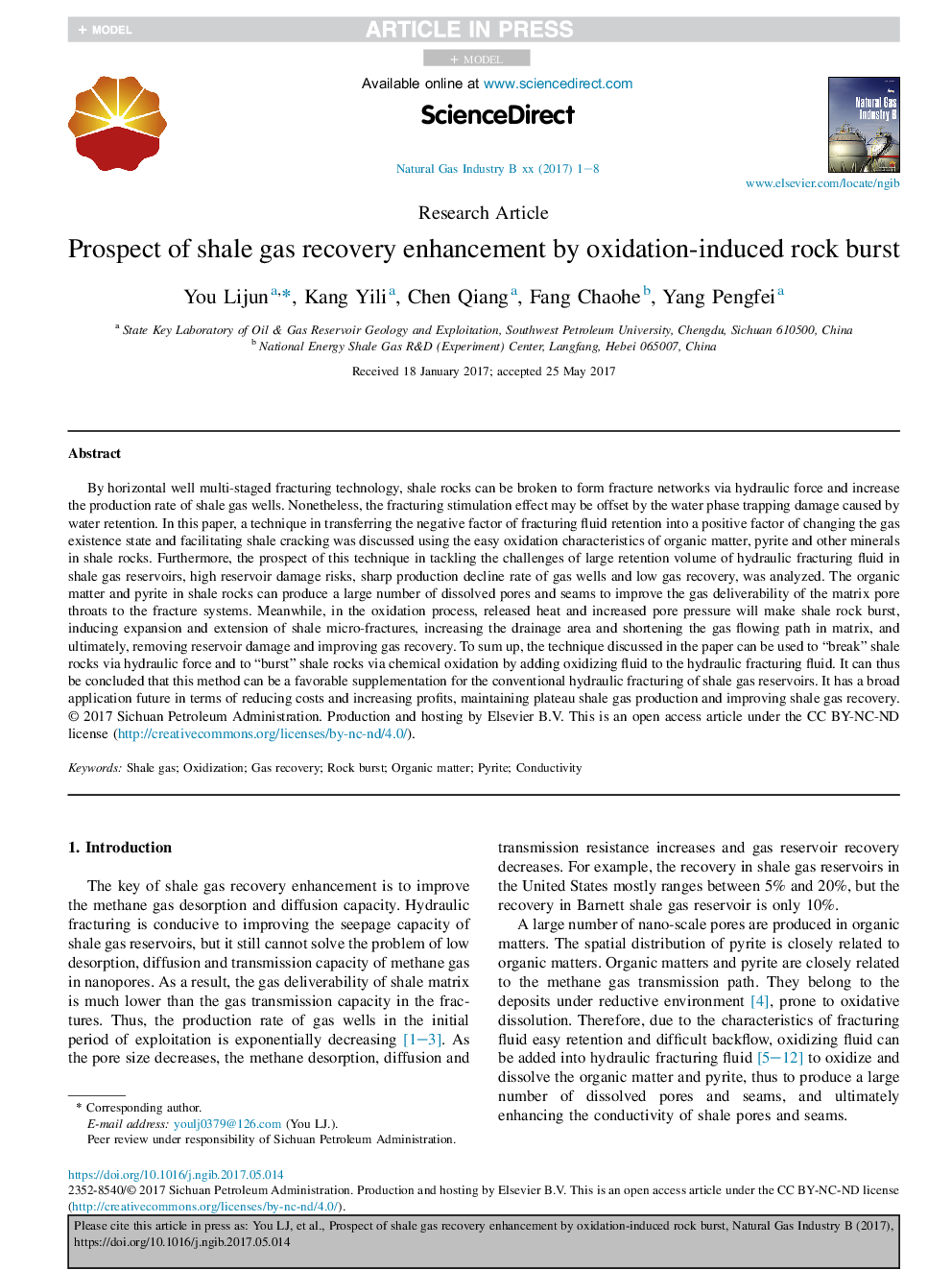| کد مقاله | کد نشریه | سال انتشار | مقاله انگلیسی | نسخه تمام متن |
|---|---|---|---|---|
| 8109644 | 1522257 | 2017 | 8 صفحه PDF | دانلود رایگان |
عنوان انگلیسی مقاله ISI
Prospect of shale gas recovery enhancement by oxidation-induced rock burst
ترجمه فارسی عنوان
چشم انداز افزایش بازیابی گاز شیل به دلیل انفجار سنگی ناشی از اکسیداسیون
دانلود مقاله + سفارش ترجمه
دانلود مقاله ISI انگلیسی
رایگان برای ایرانیان
کلمات کلیدی
گاز شیل، اکسیداسیون، بازیافت گاز، رکورد راک، مواد ارگانیک، پریت، هدایت،
ترجمه چکیده
با استفاده از فن آوری شکستگی افقی و چند مرحله ای، سنگ های شیل می توانند شکسته شوند تا شبکه های شکست را از طریق نیروی هیدرولیکی ایجاد کنند و میزان تولید چاه های گاز شیل را افزایش دهند. با این وجود، اثر تحریک شکستگی ممکن است توسط آسیب های تله فاکتور آب توسط آب نگه داشته شود. در این مقاله، تکنیک انتقال غلظت مایع شکست شکستگی به یک عامل مثبت تغییر حالت گاز و تسهیل ترک خوردگی شیلر با استفاده از ویژگی های آسان اکسیداسیون مواد آلی، پیریت و سایر مواد معدنی در سنگ های شیل مورد بحث قرار گرفته است. علاوه بر این، چشم انداز این روش در مقابله با چالش های حجم نگهداری بزرگ از مایع شکستن هیدرولیک در مخازن گاز شیل، خطرات آسیب بالا مخزن، کاهش شدید تولید چاه های گاز و بازیابی گاز کم تجزیه و تحلیل شده است. مواد ارگانیک و پیریت در سنگ های شیل می تواند تعداد زیادی از منافذ و انحلال منافذ را تولید کند تا برای تحویل گاز از گریپ فروت ماتریکس به سیستم های شکستگی بهبود یابد. در همین حال، در فرایند اکسیداسیون، گرما آزاد شده و افزایش فشار منفی، موجب انفجار سنگ های شیل خواهد شد، موجب گسترش و گسترش شکستگی های میکرو شیل، افزایش سطح زهکشی و کاهش مسیر جریان گاز در ماتریکس، و در نهایت، از بین بردن آسیب های مخزن و بهبود بازیابی گاز. به طور خلاصه، تکنیک مورد بحث در مقاله می تواند مورد استفاده قرار گیرد؟ سنگ های شیل از طریق نیروی هیدرولیکی سنگ های شیل از طریق اکسیداسیون شیمیایی با افزودن مایع اکسید کننده به مایع شکستگی هیدرولیکی. بنابراین می توان نتیجه گرفت که این روش می تواند یک مکمل مطلوب برای شکستن هیدرولیکی مخازن گاز شیل باشد. از نظر هزینه کاهش هزینه ها و افزایش سود، حفظ تولید گاز شیل پلاتو و بهبود بازیابی گاز شیل، آینده ای گسترده دارد.
موضوعات مرتبط
مهندسی و علوم پایه
مهندسی انرژی
مهندسی انرژی و فناوری های برق
چکیده انگلیسی
By horizontal well multi-staged fracturing technology, shale rocks can be broken to form fracture networks via hydraulic force and increase the production rate of shale gas wells. Nonetheless, the fracturing stimulation effect may be offset by the water phase trapping damage caused by water retention. In this paper, a technique in transferring the negative factor of fracturing fluid retention into a positive factor of changing the gas existence state and facilitating shale cracking was discussed using the easy oxidation characteristics of organic matter, pyrite and other minerals in shale rocks. Furthermore, the prospect of this technique in tackling the challenges of large retention volume of hydraulic fracturing fluid in shale gas reservoirs, high reservoir damage risks, sharp production decline rate of gas wells and low gas recovery, was analyzed. The organic matter and pyrite in shale rocks can produce a large number of dissolved pores and seams to improve the gas deliverability of the matrix pore throats to the fracture systems. Meanwhile, in the oxidation process, released heat and increased pore pressure will make shale rock burst, inducing expansion and extension of shale micro-fractures, increasing the drainage area and shortening the gas flowing path in matrix, and ultimately, removing reservoir damage and improving gas recovery. To sum up, the technique discussed in the paper can be used to “break” shale rocks via hydraulic force and to “burst” shale rocks via chemical oxidation by adding oxidizing fluid to the hydraulic fracturing fluid. It can thus be concluded that this method can be a favorable supplementation for the conventional hydraulic fracturing of shale gas reservoirs. It has a broad application future in terms of reducing costs and increasing profits, maintaining plateau shale gas production and improving shale gas recovery.
ناشر
Database: Elsevier - ScienceDirect (ساینس دایرکت)
Journal: Natural Gas Industry B - Volume 4, Issue 6, November 2017, Pages 449-456
Journal: Natural Gas Industry B - Volume 4, Issue 6, November 2017, Pages 449-456
نویسندگان
Lijun You, Yili Kang, Qiang Chen, Chaohe Fang, Pengfei Yang,
